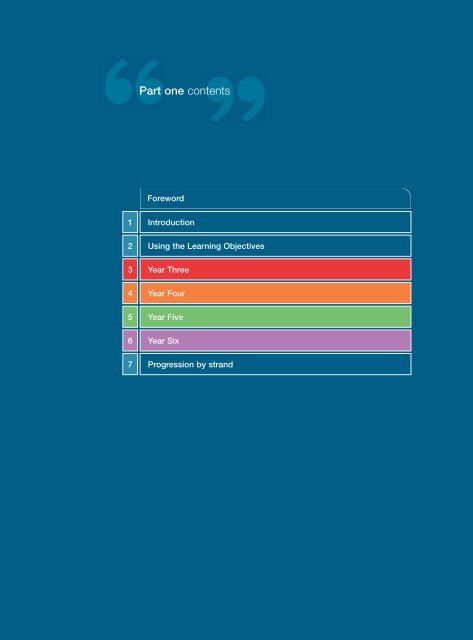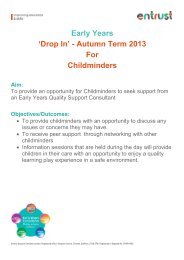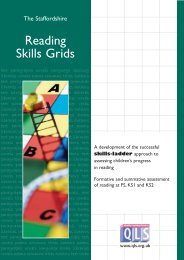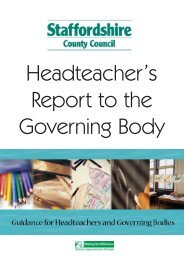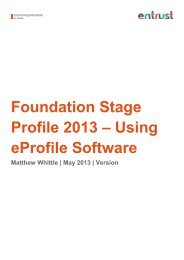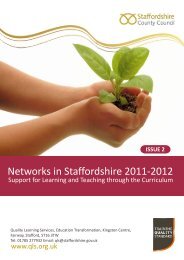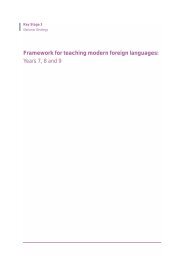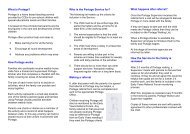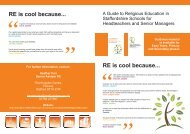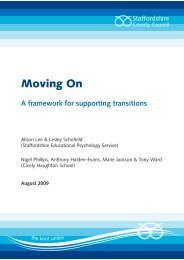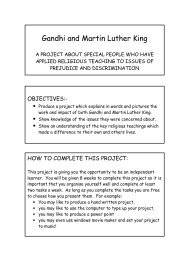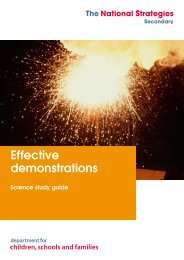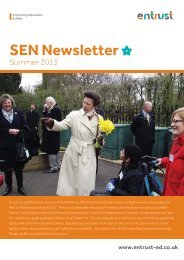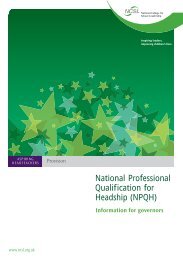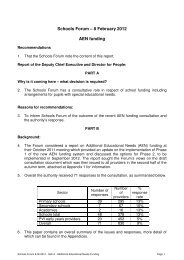KS2 Framework for Languages - Staffordshire Learning Net
KS2 Framework for Languages - Staffordshire Learning Net
KS2 Framework for Languages - Staffordshire Learning Net
Create successful ePaper yourself
Turn your PDF publications into a flip-book with our unique Google optimized e-Paper software.
Part one contents<br />
Foreword<br />
1 Introduction<br />
2 Using the <strong>Learning</strong> Objectives<br />
3 Year Three<br />
4 Year Four<br />
5 Year Five<br />
6 Year Six<br />
7 Progression by strand
Foreword<br />
The centrepiece of the National <strong>Languages</strong> Strategy <strong>Languages</strong> <strong>for</strong> All <strong>Languages</strong> <strong>for</strong> Life is<br />
our commitment to give every child between the ages of 7 and 11 the entitlement to learn a<br />
new language. This marks a fundamental shift in our approach to language learning in this<br />
country and, by 2010 will trans<strong>for</strong>m the shape of language learning in our schools.<br />
<strong>for</strong>eword<br />
Much has already been achieved. We have been working with 19 Pathfinder Local Authorities<br />
to learn lessons about sustainable models <strong>for</strong> primary languages. We have developed new<br />
primary teacher training courses with languages and have piloted training courses <strong>for</strong> teachers<br />
and teaching assistants. Specialist Language Colleges, Comenius Centres and Higher<br />
Education Institutions are working with Local Authorities to help build this primary capacity<br />
and throughout England plans are now in place <strong>for</strong> a significant expansion of provision in<br />
the coming period.<br />
One outstanding characteristic of all of the work that we have seen so far has been the<br />
commitment of Local Authorities and schools as they take up this challenge. This has been<br />
mirrored in the dedication of the teachers involved and, most important of all, the enthusiasm<br />
and enjoyment of so many young people.<br />
We are determined to build on and foster this enthusiasm and commitment. In doing so we<br />
must also ensure that it develops coherently and successfully, becoming embedded in the<br />
primary curriculum of the 21st century and providing a stimulating and well rooted foundation<br />
<strong>for</strong> language learning in secondary schools. That is why we have decided to publish a national<br />
Key Stage 2 <strong>Framework</strong> <strong>for</strong> <strong>Languages</strong>, which will be the focus of our long-term support <strong>for</strong><br />
primary entitlement. The intention is to provide a nationally agreed point of reference, which<br />
is flexible enough to take account of the many different starting points on this road to full<br />
entitlement, and at the same time visionary enough to show what will be possible.<br />
In <strong>Languages</strong> <strong>for</strong> All <strong>Languages</strong> <strong>for</strong> Life – we recognised that the achievement of full primary<br />
entitlement is both critical to our strategy and a major educational and cultural challenge.<br />
As the <strong>Framework</strong> objectives themselves make clear, this is not only a matter of developing<br />
competence in one or more languages, crucial as this is. It is also about the broader curriculum<br />
– about understanding language and identity, about developing an international outlook, and<br />
about learning. It is about inclusiveness and opportunities <strong>for</strong> all of our children. It is about the<br />
kind of people they will become and the kind of world in which they will live. These are some of<br />
the reasons, I believe, why so many of you are enthused by the idea of language learning in the<br />
primary school. This is also why the publication of the Key Stage 2 <strong>Framework</strong> <strong>for</strong> <strong>Languages</strong><br />
is so important both <strong>for</strong> the success of our primary strategy and <strong>for</strong> the future of our children.<br />
Andrew Adonis<br />
Parliamentary Under-Secretary of State <strong>for</strong> Schools<br />
The Key Stage 2 <strong>Framework</strong> <strong>for</strong> <strong>Languages</strong> – Foreword<br />
1
1 Introduction<br />
The National <strong>Languages</strong> Strategy 3<br />
The <strong>Framework</strong> as a Point of Reference 5<br />
Overview of the <strong>Learning</strong> Objectives 6<br />
1
The National <strong>Languages</strong> Strategy<br />
The National <strong>Languages</strong> Strategy <strong>for</strong> England sets out the Government’s commitment to<br />
increasing the nation’s languages capability, and a vision of languages as “a life long skill –<br />
to be used in business and <strong>for</strong> pleasure, to open up avenues of communication and<br />
exploration, and to promote, encourage and instill a broader cultural understanding” (page 5).<br />
The cornerstone of that strategy is the introduction by 2010 of an entitlement to language<br />
learning <strong>for</strong> every pupil in Key Stage 2.<br />
“Every child should have the opportunity throughout Key Stage 2 to study a <strong>for</strong>eign<br />
language and develop their interest in the culture of other nations. They should have<br />
access to high quality teaching and learning opportunities, making use of native speakers<br />
and e-learning. By age 11 they should have the opportunity to reach a recognised level of<br />
competence on the Common European <strong>Framework</strong> and <strong>for</strong> that achievement to be<br />
recognised through a national scheme.” (page 15)<br />
The National <strong>Languages</strong> Strategy is also an important element within the Primary National<br />
Strategy, rein<strong>for</strong>cing the key approaches to teaching and learning, which are set out in<br />
Excellence and Enjoyment, a strategy <strong>for</strong> primary schools. In developing the <strong>Framework</strong>,<br />
careful attention has been given to how best to achieve the most positive outcomes <strong>for</strong><br />
children, taking full account of the vision and intentions as set out in Every Child Matters .<br />
The <strong>Framework</strong> is a core document, offering a practical reference tool <strong>for</strong> planning, teaching<br />
and monitoring the learning process. The <strong>Framework</strong> is designed to support primary school<br />
teachers in building their own courses. It also aims to provide secondary school teachers who<br />
support primary teachers with a way of making their specialist linguistic knowledge relevant <strong>for</strong><br />
the primary classroom. The <strong>Framework</strong> will also be of use to:<br />
• Headteachers<br />
• Teaching assistants<br />
• Secondary schools preparing <strong>for</strong> transition<br />
• Teacher trainers<br />
• Curriculum planners<br />
• Course and resource developers.<br />
one<br />
The Key Stage 2 <strong>Framework</strong> <strong>for</strong> <strong>Languages</strong> – Introduction<br />
3
4<br />
The Government’s plans <strong>for</strong> primary languages are <strong>for</strong> full implementation by 2010. This is an<br />
ambitious but achievable target <strong>for</strong> nearly 18,000 primary schools attended by children in <strong>KS2</strong><br />
and almost 2.5 million children. In using the <strong>Framework</strong> it is important to realise that it can be<br />
introduced over time. It should provide teachers and planners with enough flexibility to support<br />
what is happening now and to plan <strong>for</strong> increasing capacity over a number of years.<br />
Above all, the <strong>Framework</strong> should be seen as a support, not a constraint; a climbing<br />
frame, not a cage.<br />
The <strong>Framework</strong> builds on key principles <strong>for</strong> teaching and learning in the following documents:<br />
• <strong>Languages</strong> <strong>for</strong> all: <strong>Languages</strong> <strong>for</strong> Life – the Government’s National Strategy <strong>for</strong> <strong>Languages</strong><br />
• Excellence and Enjoyment – a Strategy <strong>for</strong> Primary Schools.<br />
The <strong>Learning</strong> Objectives have been linked to:<br />
• The objectives <strong>for</strong> English, PSHE, Geography, History, Art and Design, Music and ICT<br />
set out in the National Curriculum Programmes of Study in Key Stages 1 and 2<br />
• National Literacy and Numeracy Strategy <strong>Framework</strong>s<br />
• Speaking, Listening and <strong>Learning</strong> – working with children in Key Stages 1 and 2<br />
jointly published by the Primary National Strategy and QCA<br />
• QCA Schemes of Work <strong>for</strong> MFL – at Key Stage 2<br />
• National Curriculum Non-statutory Guidelines <strong>for</strong> MFL – at Key Stage 2.<br />
It also draws on the <strong>Framework</strong> <strong>for</strong> teaching modern <strong>for</strong>eign languages: Years 7, 8<br />
and 9 produced by the Key Stage 3 National Strategy.
The <strong>Framework</strong> as a Point of Reference<br />
The <strong>Framework</strong> is available on-line at www.standards.dfes.gov.uk/primary/languages and<br />
in hard copy, and it is supplemented by two sets of support materials.<br />
Part 1 – the <strong>Framework</strong> itself sets out:<br />
• <strong>Learning</strong> objectives which show progression over the four years of Key Stage 2 in<br />
Oracy, Literacy and Intercultural Understanding<br />
• Two ‘cross-cutting’ strands showing how Knowledge about Language (KAL) and<br />
Language <strong>Learning</strong> Strategies (LLS) relate to these objectives<br />
• Sample teaching activities.<br />
Part 2 provides more targeted advice <strong>for</strong> different users of the <strong>Framework</strong> – those who are<br />
introducing primary languages from scratch, those who have experience of teaching primary<br />
languages, those with responsibility <strong>for</strong> managing and co-ordinating the curriculum and those<br />
working in Key Stage 3 who will be supporting primary language learning and transition.<br />
Part 3 of the framework documentation – Planning <strong>for</strong> Entitlement will be available to schools<br />
from the spring term of 2005/2006. A comprehensive range of materials offers detailed<br />
guidance on whole-school planning to teachers and head teachers as they introduce<br />
languages into the primary curriculum. The materials include planning tools and detailed<br />
explanations of how to embed language learning through cross-curricular links. They also<br />
provide a spotlight on matters such as how to plan <strong>for</strong> progression in one language over four<br />
years, how to plan <strong>for</strong> a multi-lingual approach, how to manage mixed-age classes, how to<br />
address the challenge of small schools, how to assess learning and record progress, how to<br />
support successful transition into Key Stage 3 and how to meet the needs of all children,<br />
including those with languages other than English.<br />
Using the <strong>Framework</strong> <strong>for</strong> curriculum design<br />
Schools can use the <strong>Framework</strong> creatively as a basis <strong>for</strong> long, medium and short-term<br />
planning, adapting it to meet the needs of their children and to match their own curriculum.<br />
The <strong>Framework</strong> does not prescribe specific topics or contexts <strong>for</strong> learning. It gives teachers the<br />
freedom to be creative and innovative and to devise programmes of work and activities, which<br />
will engage, excite and challenge children. The course content should be stimulating, enjoyable<br />
and challenging, reflecting children’s increasing maturity and offering them inspiration to<br />
communicate and use language creatively and imaginatively.<br />
To assist with planning, sample activities illustrating how each objective might look in the<br />
classroom accompany the statements. These assume some of the most common content<br />
areas currently used in primary languages, <strong>for</strong> example – the world of imagination, self and<br />
home, the classroom. This is in no sense, however, intended to be prescriptive. These activities<br />
serve as prompts to stimulate teachers’ own creative ideas and do not constitute a course or<br />
scheme of work. Schools should feel free to create their own courses and teaching activities,<br />
relevant to the experiences and interests of their own children.<br />
one<br />
The Key Stage 2 <strong>Framework</strong> <strong>for</strong> <strong>Languages</strong> – Introduction<br />
5
6<br />
The <strong>Framework</strong> has been devised to enable schools to build motivating and imaginative<br />
teaching plans and units, which deal with topics of real interest and relevance to children, and<br />
reflect the richness and diversity of our society These should also fit in with schools’ aims <strong>for</strong><br />
the whole curriculum, building on the principles described in Excellence and Enjoyment: a<br />
strategy <strong>for</strong> primary schools. The <strong>Framework</strong>’s objectives can link with many different subjects<br />
in the primary curriculum, providing opportunities to integrate work in languages with that of<br />
the rest of the school. For example, many elements of the learning objectives <strong>for</strong> languages<br />
rein<strong>for</strong>ce the curriculum content in citizenship, literacy, mathematics, P.E. and geography and<br />
could be taught through these subjects.<br />
Overview of the <strong>Learning</strong> Objectives<br />
The <strong>Learning</strong> Objectives represent the core material on which teachers can build in order<br />
to provide entitlement to language learning in <strong>KS2</strong>. They are general statements that show<br />
progression and support teachers in planning to cover the main areas of learning.<br />
The Objectives comprise three clearly progressive core strands of teaching and learning,<br />
over the four years of <strong>KS2</strong>:<br />
• Oracy<br />
• Literacy<br />
• Intercultural understanding.<br />
In addition, two cross-cutting strands are included:<br />
• Knowledge about Language (KAL)<br />
• Language <strong>Learning</strong> Strategies (LLS).<br />
These are of value in themselves as important tools <strong>for</strong> learning, providing a basis <strong>for</strong> children’s<br />
future development as language learners. They are conceived of as both arising from and<br />
supporting the core teaching and learning strands rather than as existing independently<br />
from them.<br />
These broad areas of teaching and learning are separated out <strong>for</strong> planning and monitoring<br />
purposes. In the classroom they will invariably be linked and mutually supportive. Schools can<br />
develop the strands in a variety of ways. Children’s progress through the stages of language<br />
learning is rarely linear and not the same <strong>for</strong> all languages or <strong>for</strong> all children. The balance of<br />
time devoted to individual strands and objectives will, there<strong>for</strong>e, vary from school to school.
Oracy<br />
Oracy (listening, speaking and spoken interaction) has a more prominent place in language<br />
learning than in most if not all other areas of the curriculum. In the early stages children will<br />
spend much of their time listening, speaking and interacting orally and will be given regular and<br />
frequent opportunities to listen to a good model of pronunciation. This emphasis on exposure<br />
to the sound patterns of the new language is particularly important because, unlike with their<br />
mother tongue, children will be reliant on the classroom to provide most of their spoken<br />
language experience.<br />
Children listen to the teacher, to songs and rhymes, to each other and to native speakers,<br />
to recorded and on-line speech and songs, recognising familiar and unfamiliar sounds.<br />
They reproduce these sounds themselves and create phrases and sentences. They engage<br />
in simple conversations to obtain and provide in<strong>for</strong>mation and exchange opinions. They also<br />
rein<strong>for</strong>ce and expand their knowledge of their own language or languages and other<br />
subject areas<br />
one<br />
The Key Stage 2 <strong>Framework</strong> <strong>for</strong> <strong>Languages</strong> – Introduction<br />
7
8<br />
Literacy<br />
The literacy skills of reading and writing are supported by, and in turn rein<strong>for</strong>ce, the<br />
development of oracy. They are likely to take on greater prominence as children become<br />
familiar with the relationship between sounds and letters/characters in the new language<br />
and apply this knowledge in their reading and spelling.<br />
As they increase their understanding of the language, they gain increasing access to different<br />
<strong>for</strong>ms of text – simple stories, poems, in<strong>for</strong>mation texts, advertisements, letters, messages –<br />
in paper and electronic <strong>for</strong>ms. Children will have opportunities to apply their skills and<br />
understanding to read, enjoy and make use of this widening range of texts.<br />
They should be able to write simple sentences and short texts <strong>for</strong> different purposes and<br />
audiences, often using a frame or model to help them structure meaning.<br />
Children use the skills of reading and writing to develop a basic knowledge of the writing<br />
system, the spelling and the structure of the language. In doing this, they rein<strong>for</strong>ce and<br />
expand their knowledge and understanding of their own language(s).<br />
Intercultural Understanding<br />
Language competence and intercultural understanding are an essential part of being a citizen.<br />
Children develop a greater understanding of their own lives in the context of exploring the lives<br />
of others. They learn to look at things from another’s perspective, giving them insight into the<br />
people, culture and traditions of other cultures. Children become more aware of the similarities<br />
and differences between peoples, their daily lives, beliefs and values. There are many<br />
opportunities to link this strand closely with work in other subjects.<br />
Objectives in this strand can be integrated into language lessons as well as taught separately<br />
in non-language teaching time, through other subjects. <strong>Learning</strong> a new language inevitably<br />
and naturally brings children into contact with aspects of the culture of other countries.<br />
The practical nature of language learning may make this contact even more real, whether<br />
inside school, on special days or beyond the classroom, by using the internet, e-mail,<br />
school trips abroad and links with other schools.
Knowledge About Language<br />
When learning a new language, children rein<strong>for</strong>ce and reinterpret knowledge and<br />
understanding gained in learning their first language(s). They develop insights into the nature<br />
of language and its social and cultural value. Building on their experience of interaction with<br />
and in the new language, they begin to increase their understanding of how language works.<br />
They compare the new language with English or another language and reflect on similarities<br />
and differences. They become aware of rules or patterns in language and begin to apply their<br />
knowledge when creating new language.<br />
Knowledge about language supports children in communicating effectively in speech and<br />
writing. It helps them to apply their prior knowledge, both to understand and to generate<br />
new language. It makes them aware of pronunciation and intonation and how these influence<br />
meaning. It helps them investigate how languages work and illustrates how users adapt<br />
language in <strong>for</strong>mal and in<strong>for</strong>mal contexts.<br />
Language <strong>Learning</strong> Strategies<br />
An important aim of language learning in <strong>KS2</strong> is to familiarise children with strategies which<br />
they can apply to the learning of any language. The <strong>Framework</strong> sets out examples of <strong>Learning</strong><br />
Strategies and ways of teaching them. Over the four years of <strong>KS2</strong> children should have regular<br />
opportunities to identify and apply a range of Language <strong>Learning</strong> Strategies.<br />
By selecting and using different strategies, children develop awareness of how they learn and<br />
the ability to plan to use specific strategies <strong>for</strong> particular tasks. Strategies explored in language<br />
lessons can also be used <strong>for</strong> learning in other subjects.<br />
The objectives show how children can progress over the course of four years. The strands<br />
are interconnected and support each other; they would rarely be taught in isolation. A typical<br />
series of lessons will include elements from three to five strands. Schools should feel free to<br />
emphasise certain strands and certain objectives to fit in with their own aims and teaching<br />
materials. Some children’s learning needs will be better matched by learning objectives from<br />
earlier or later years.<br />
one<br />
The Key Stage 2 <strong>Framework</strong> <strong>for</strong> <strong>Languages</strong> – Introduction<br />
9
2 Using the <strong>Learning</strong> Objectives<br />
Structure of the framework 11<br />
2
Structure of the <strong>Framework</strong><br />
The <strong>Learning</strong> Objectives <strong>for</strong> each year begin with a summary of the expectations <strong>for</strong> learning<br />
and teaching and an overview of outcomes describing what most children should be able to<br />
do by the end of the year – Expectations and Outcomes (<strong>for</strong> example as in page 18).<br />
This is followed by the ‘Part 3 at a glance’ page, which summarises the learning objectives<br />
from each of the five strands <strong>for</strong> the year. These pages have been designed <strong>for</strong> ease of<br />
reference to give an overview of all the learning objectives and to illustrate how they might<br />
interconnect. Schools may, of course, choose to use objectives from earlier or later years<br />
depending on the abilities, experiences and aptitudes of the children. The ‘at a glance’ pages<br />
are best used <strong>for</strong> monitoring and reviewing the programme of work. More detailed planning<br />
should be based on the comprehensive <strong>Learning</strong> Objectives sections.<br />
The core <strong>Learning</strong> Objectives <strong>for</strong> Oracy, Literacy and Intercultural Understanding are<br />
progressive and are listed in full <strong>for</strong> each year. The cross-cutting strands, Knowledge<br />
about Language (KAL) and Language <strong>Learning</strong> Strategies (LLS) are by their nature recursive.<br />
They contain samples of key objectives and activities, which can be integrated with the<br />
<strong>Learning</strong> Objectives <strong>for</strong> the progressive strands. The LLS, in particular, include strategies<br />
which are relevant <strong>for</strong> all four years of Key Stage 2 at different levels of complexity.<br />
For this reason, objectives <strong>for</strong> KAL and LLS do not have specific outcomes defined by<br />
year. Children revisit and expand their knowledge about language and their language<br />
learning strategies throughout the language learning process.<br />
The <strong>Learning</strong> Objectives by year are set out in a double-page spread so that teachers can<br />
easily read across from the learning objectives to the learning opportunities and see how these<br />
link to and are underpinned by Knowledge about Language and Language <strong>Learning</strong> Strategies.<br />
The <strong>Learning</strong> Objectives <strong>for</strong> the core strands of Oracy, Literacy and Intercultural Understanding<br />
are also listed in a separate section by strand. This <strong>for</strong>mat is intended to support teachers in<br />
monitoring progression across years within each strand. It will be of particular help <strong>for</strong> those<br />
teachers planning programmes of learning <strong>for</strong> children in mixed-age classes.<br />
two<br />
The Key Stage 2 <strong>Framework</strong> <strong>for</strong> <strong>Languages</strong> – Using the <strong>Learning</strong> Objectives<br />
11
12<br />
How the strands interrelate<br />
The five strands are interdependent and schools can develop them in a variety of ways.<br />
They would rarely be taught in isolation and many lessons will include elements from<br />
all strands. In particular:<br />
Oracy underpins Literacy and is in turn supported by it, <strong>for</strong> example:<br />
O3.4 Listen attentively and understand instructions, everyday classroom language<br />
and praise words<br />
links to<br />
L3.1 Recognise some familiar words in written <strong>for</strong>m<br />
Intercultural Understanding provides content <strong>for</strong> developing oral interaction or reading,<br />
<strong>for</strong> example:<br />
IU4.3 Compare traditional stories<br />
links to<br />
L4.2 Follow a short familiar text, listening and reading at the same time<br />
Knowledge about language arises from language activity and also rein<strong>for</strong>ces learning,<br />
<strong>for</strong> example:<br />
O4.4 Ask and answer questions on several topics<br />
is supported by KAL<br />
(O3.3) Recognise question <strong>for</strong>ms; (O4.4) Use question <strong>for</strong>ms<br />
Language <strong>Learning</strong> Strategies are part of the learning process, <strong>for</strong> example:<br />
O3.1 Listen and respond to simple rhymes, stories and songs<br />
links to Language <strong>Learning</strong> Strategy<br />
(O3.1) Remember rhyming words
Inclusion<br />
Teachers using the <strong>Framework</strong> may need to adapt it in order to ensure that it takes full<br />
account of the different experiences, strengths and interests of their pupils. In doing this<br />
they will need to take account of the statutory requirements and guidance on inclusion set<br />
out in the national curriculum.<br />
The statutory inclusion statement sets out three principles that are essential to developing a<br />
more inclusive curriculum:<br />
• Setting suitable learning challenges<br />
• Responding to the diverse needs of children<br />
• Overcoming potential barriers to learning and assessment <strong>for</strong> individuals and groups<br />
of children.<br />
The type of support provided <strong>for</strong> children with difficulties in communication, language and<br />
literacy could include:<br />
• Using alternative and augmentative communication<br />
• Reducing the amount of written work and reading<br />
• Giving children the opportunity to clarify their ideas through discussion, role play and the<br />
use of tape recorders, video, and photographs, rather than relying on written materials.<br />
It may be necessary to use specialist equipment to give motivating and relevant experiences<br />
to children with sensory and physical disabilities.<br />
two<br />
The Key Stage 2 <strong>Framework</strong> <strong>for</strong> <strong>Languages</strong> – Using the <strong>Learning</strong> Objectives<br />
13
An overview of the <strong>Learning</strong> Objectives<br />
The three progressive strands of teaching and learning – Oracy, Literacy and Intercultural<br />
Understanding – are set out in terms of learning objectives and suggested learning<br />
opportunities <strong>for</strong> each year. Opportunities to develop Knowledge About Language (KAL)<br />
and Language <strong>Learning</strong> Strategies (LLS) are made explicit and underpin the three<br />
core strands. Suggestions <strong>for</strong> KAL and LLS are provided <strong>for</strong> each learning objective.<br />
The <strong>Learning</strong> Objectives are designed to help schools devise their own courses.<br />
Schools should select suitable objectives which fit with their curriculum plans, children’s<br />
abilities and the interests and expertise of the staff. Schools may also choose to use<br />
objectives from earlier or later years, depending on the range of ages and aptitudes<br />
within the class, and on the children’s prior experience of learning a language.<br />
Year 4<br />
<strong>Learning</strong> Objectives<br />
Children should be taught to:<br />
O4.1 Memorise and present a short<br />
spoken text<br />
Year 3 children should, <strong>for</strong> example:<br />
Identify rhyming words.<br />
Per<strong>for</strong>m finger rhymes and sing songs.<br />
Join in with storytelling.<br />
<strong>Learning</strong> Opportunities signpost the kind of experiences that should be provided <strong>for</strong><br />
children in order to meet the <strong>Learning</strong> Objectives. The suggested activities are<br />
interdependent and are designed to be viewed together not in isolation.<br />
Teaching activities showing how the learning objectives might be developed in the classroom are provided at<br />
the end of each section. These activities serve as guidance only and do not constitute a course or scheme of<br />
work. Schools should feel free to make the objectives their own, creating their own imaginative content and<br />
teaching activities.<br />
Knowledge about Language (KAL). The KAL strand is integrated with the strands <strong>for</strong><br />
oracy, literacy and intercultural understanding. In most cases opportunities <strong>for</strong> children<br />
to develop a more explicit understanding and control of the new language will arise<br />
from the learning activities. Teachers may also choose to review this understanding<br />
periodically in the context of general literacy.<br />
<strong>Learning</strong> Opportunities Knowledge about Language Language <strong>Learning</strong> Strategies<br />
Children should have opportunities to,<br />
<strong>for</strong> example:<br />
Identify specific sounds, phonemes and words.<br />
Recognise commonly-used rhyming sounds.<br />
Children should have opportunities to,<br />
<strong>for</strong> example:<br />
Remember rhyming words.<br />
Use gesture or mime to show they understand.<br />
Language <strong>Learning</strong> Strategies will help children become more independent<br />
learners in any language. These examples are not exclusive and children should<br />
be encouraged to discuss strategy use and to expand their range of strategies<br />
by sharing with other children and the teacher.<br />
two<br />
The Key Stage 2 <strong>Framework</strong> <strong>for</strong> <strong>Languages</strong> – Using the <strong>Learning</strong> Objectives<br />
15


